Any time you lose by 38 points, the post mortem review must look at the defence and how those points were leaked.
In Bledisloe III, the All Blacks tries didn’t come directly off Wallabies turnovers, as we’ve become accustomed to seeing from the men in black. Instead, many were constructed and delivered off set-piece. This will be incredibly concerning for Dave Rennie’s side.
At the set-piece, the defence has time to set and plan for the phases ahead. This should be the hardest time for an attacking side to score, but it was a walkthrough at times for the All Blacks in Sydney.
Forget about attacking shapes, strikes moves, offloads and the rest of it – the Wallabies defence must improve dramatically to have any chance of winning the fourth and final test in Brisbane. A solid performance is needed not to just to compete with the All Blacks, but to put forth a key building block in their development as a genuine test side. The showing in the third test was an alarming regression.
It was never going to be easy for the backline losing the experience of James O’Connor and Matt To’omua to injury, but with more unforced changes by Rennie, this Wallabies side was lacking a basic understanding in their defensive system, while at the same time, tried to make adjustments to cover weaknesses from Bledisloe II.
There is no shortage of blame to go around. The Wallabies back-rowers were robotic in their fold after set-piece with no consideration for what the All Blacks were doing.
The back three were hopelessly deep, unable to read the play and swing in a pendulum motion between kick coverage and edge defence.
And Nic White, arguably the player of the opening Bledisloe Cup match, was floating between edge defence and sweeper and made some costly decisions just when his side needed him most.
This was not the same side that drew in Wellington. This wasn’t even the team that valiantly fought at Eden Park. This was a shambolic showing where communication breakdowns occurred at an alarming rate and led to some of the softest defence you will see in international rugby.
From the early minutes of the match, the Wallabies were making basic errors.

Faced with an early test of their goal line defence in the seventh minute of the game, Australia had to defend without their right wing, Filipo Daugunu (14), who was in the sin bin thanks to an overexuberant aerial challenge on Caleb Clarke.
Halfback White (9) was stationed on the short side to cover this edge along with Brandon Paenga-Amosa (2), out of sight behind the maul above. With the knowledge that they are don’t have a right winger, what happened next was inexplicable.
The All Blacks used their base attacking formation, using Jack Goodhue as a flat running option hard off the maul. Goodhue tried to play Richie Mo’unga (10) out the back but a great read from Marika Koroibete (11) shut down the play and gave the All Blacks a net loss on the first phase.

The Wallabies were in a position of strength but quickly went from having the upper hand to conceding a try in a heartbeat.
This opening try was so soft and the decision-making so inexcusable that serious questions need to be asked in the Wallabies review session.
Michael Hooper (7), who originally was a guard defender to the left of the maul, decided to compete at the breakdown which took him out of the line. The rest of the Wallabies back row, Harry Wilson (8) and Ned Hanigan (6), went through the motions of folding over the ruck without keeping eyes on the All Black pack, all of whom stayed on the short side.
Making matters worse, the edge defenders, White (9) and Paenga-Amosa, folded as well. With no right wing, the Wallabies left their two props as the last two defenders on the right edge.
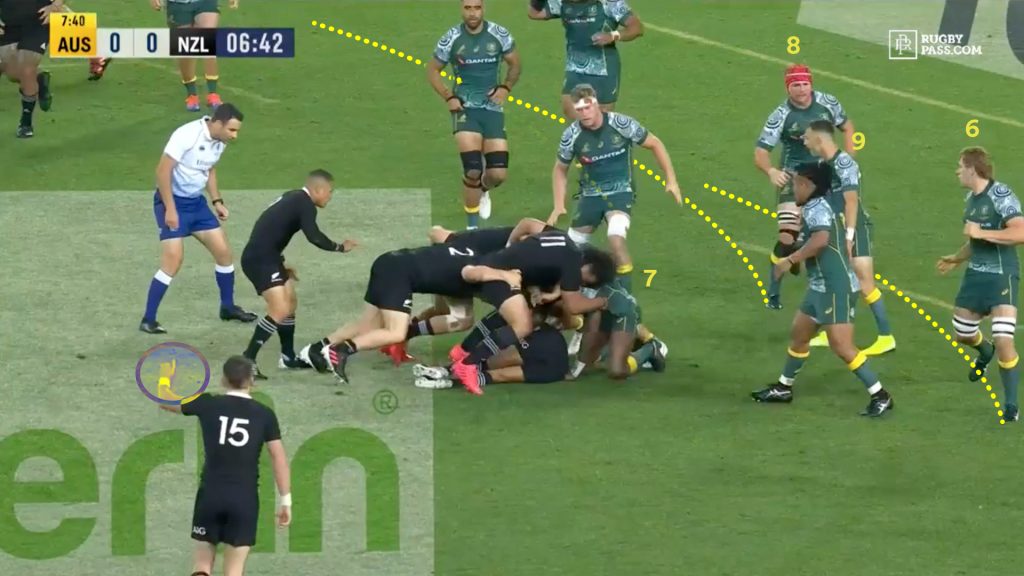
This is a nightmare situation made all the more confusing given the Wallabies had won the first phase. To capitulate so fast into a disorganised state is unacceptable.
There seemed to be no communication, no eyes up on what the All Blacks were doing. There are no excuses for White, who left his props out to dry as the only edge defenders when they didn’t have a right wing on the field.

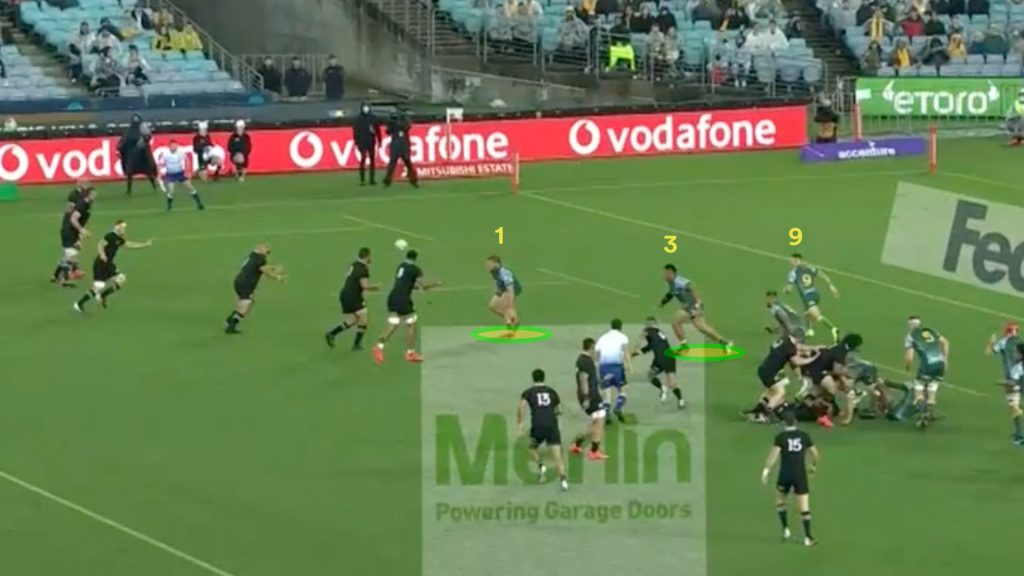
The Wallabies were almost let off the hook when prop Karl Tu’inukuafe tucked the ball and ran instead of passing to any of his support outside, but such was the disorganisation in the Wallabies defensive line, he scored anyway.
Being down a man is one thing, but not even making your opposition work hard to exploit that advantage is another. This opening try was so soft and the decision-making so inexcusable that serious questions need to be asked in the Wallabies review session. The lack of awareness is astounding for an international side, and all the more confusing given how well they defended the same type of switch play in just a few weeks earlier.
Heading into the final quarter of the match in Wellington, the All Blacks also tried to trick the Wallabies defence. Following the first phase crash by Goodhue from the line out, you can see both White (9) and Pete Samu (8) held back and stayed on the edge instead of folding over.

The All Blacks tried a wrap around play with Aaron Smith looping off his two forwards but both Wallabies read the play early and rushed up to block the passing lanes. Pete Samu did a great job of ‘swimming’ past the forwards to pressure Smith and force a disrupted pass.
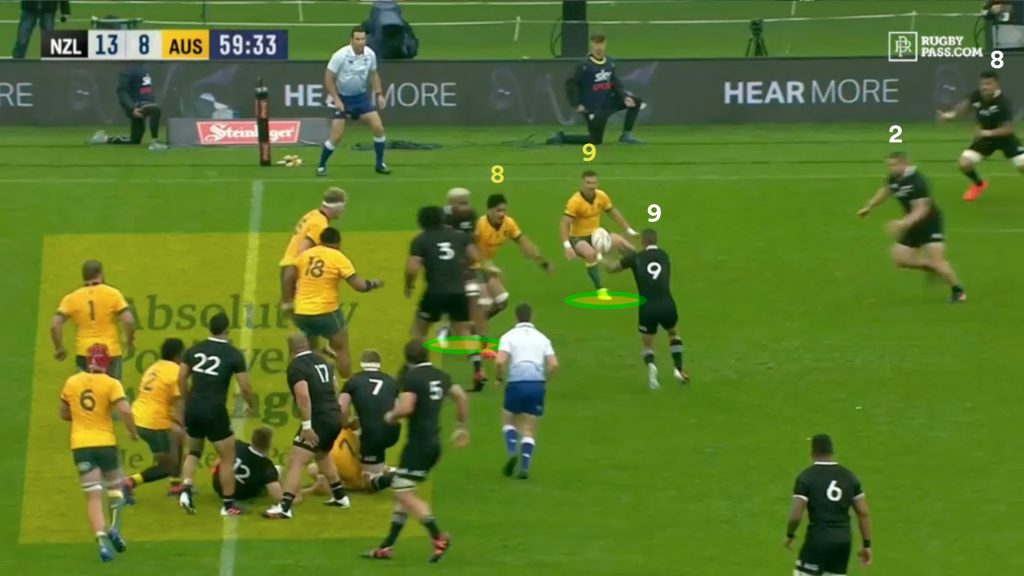

It’s a far cry from what happened when faced with virtually the same offensive structure in Sydney. After just three weeks, the Wallabies seemed unable to do things they comfortably had controlled in Wellington.
Perhaps the Wallabies’ lack of structure was due to the lack of leadership and experience in the midfield. After having their 10-channel pounded at Eden Park, Australia made the adjustment to put left wing Koroibete (11) at inside centre in the red zone to give rookie Noah Lolesio (10) some outside help.
This simply added to the confusion around what to do with their setup when Daugunu was in the sin bin.
Koroibete is seen below defending outside Lolesio in the 10-12 channel, while White is defending in the backfield on the left in Koroibete’s place out of shot. With fullback Haylett-Petty up in the front line on the far side, White has to play a quasi fullback-left wing sweeping role in behind, but also protect the left edge if the All Blacks attack the short side.

However, the All Blacks were also down a man, right wing Jordie Barrett (14), making it even. Despite not having their own right winger, they attack the Wallabies on a short side switch again, where Koroibete would normally be if he wasn’t defending at 12.
The Wallabies should have known that something was up when Clarke (11) was taken off his left wing to play the role of the right wing on this play. The Wallabies pre-play positioning would have cost them another try if not for a miraculous cover tackle from Koroibete (11) backtracking from the midfield.

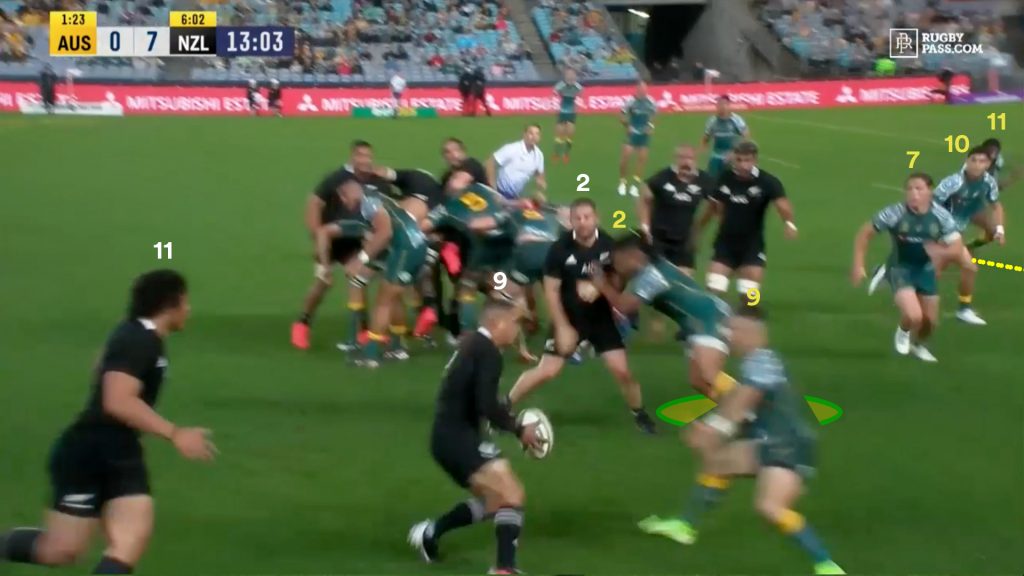
The All Blacks manufactured a quick three-on-two opportunity down the short side and got Clarke away down the edge. White (9) could not close from the backfield in time to stop his opposite Smith from getting his pass away.
Clarke was in the clear and only Koroibete’s brilliant save prevented the try.

The issue with this is schematically the Wallabies were beat easily. Although the All Blacks did not score, it was a warning shot. You cannot keep giving them chances like this or they eventually will score.
If the Wallabies wanted Koroibete to still cover the midfield channel, Dane Haylett-Petty from the opposite side should have moved with Caleb Clarke and bolstered the left side defence. The All Blacks had no left wing to speak of, yet the Wallabies left a man out there to cover no one, putting White under pressure to play two positions.
That’s not the only time the Wallabies didn’t adjust for Jordie Barrett’s absence.
When Koroibete was back in kick coverage, he was so far deep he couldn’t help the front line when needed. With Barrett in the bin, the All Blacks right side was left vacant at an attacking scrum late in the first quarter. Koroibete, on the left hand side of the park, is so far back that he is out of picture.


The All Blacks again used Goodhue to carry hard and direct at the Wallabies 10 channel. White was there to provide inside support to Lolesio in the contact, meaning he couldn’t cover the left edge.
The Wallabies were left in the exact same situation when they conceded the first try, this time with all three loose forwards folding over. With White occupied in the ruck, the Wallabies again had no speed on back side defence, with only front rowers.


Smith switched play back again to expose the Wallabies on the back side edge and Dane Coles was able to run unobstructed down the sideline before putting in a mistimed kick.

Koroibete is still not visible when Coles kicked ahead, highlighting just how poor the back three coverage was in this game.
He should have been in a position to tackle Coles, pushing up once he identified the ball was switching back to the short side. Fullback Haylett-Petty would ‘roll over’ the backfield coverage to his side and Daugunu would drop back on his side. Because Koroibete was so deep to begin with, he couldn’t do it. This poor backfield coverage would be exploited later in the half by Beauden Barrett when the opportunity arose.
With both sides back to a full compliment of players, the Wallabies made another defensive adjustment at lineout time. Koroibete still lined up at 12, but this time it was Hooper defending at 10, with Lolesio playing the winger sweep role in the backfield.
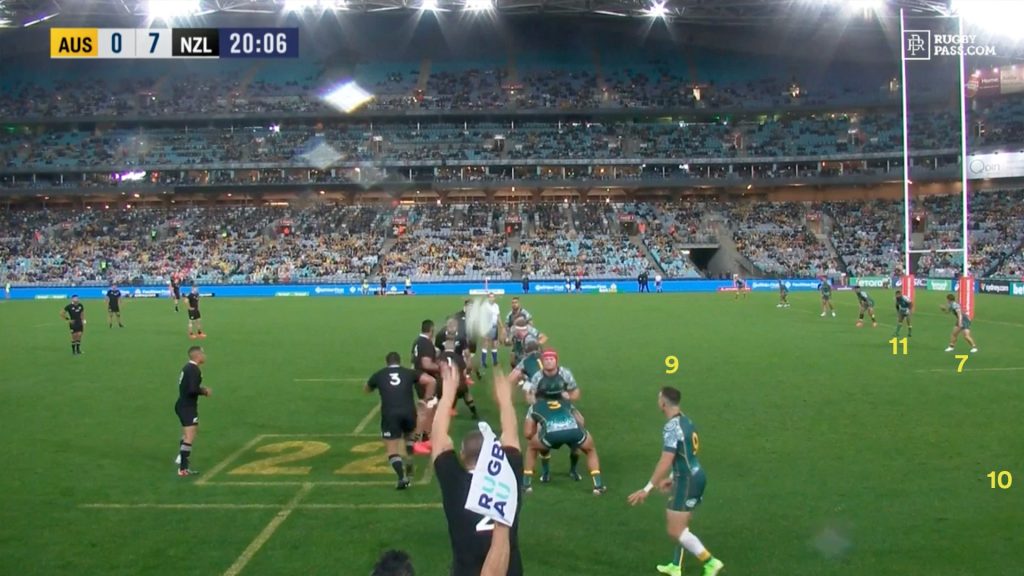
After the line out was secured, the All Blacks deliberately drove the maul infield to create more space for the switch back towards the blind. This was a clever aspect of the design on this play, increasing the space that Mo’unga had to work with.

The All Blacks isolated Paenga-Amosa (2) and White (9) as the only two defenders on a ‘larger’ short side. Smith bounced out to the open side on a halfback run before playing Mo’unga underneath, switching play back to the short side.


Whilst their is no direct numbers advantage this time, the All Blacks did create a two-on-two with a direct mismatch with flyhalf Mo’unga (10) on hooker Paenga-Amosa (2). There is too much space for Mo’unga to attack Paenga-Amosa with.

White (9) covered the outside man Barrett (14) with perhaps misguided trust that Paenga-Amosa could reach Mo’unga.
This was a fair decision by White, however, as he still had the passing line blocked to Barrett once Mo’unga skipped past the Wallabies hooker.
A one-on-one of Mo’unga versus Lolesio was a better percentage matchup for the Wallabies than Jordie Barrett versus Lolesio, which would have occurred if White jammed in on the All Black 10.
Barrett, with his size and power, would have been much harder to stop for the young flyhalf than Mo’unga. The problem for Lolesio is he sat back on his heels and gave Mo’unga too much time and space. It is extremely hard to stop anyone in this position a few metres from your goal line standing still.
Mo’unga could’ve gone either way or even through him and still scored. In the end, he went to the outside and broke through a feeble attempt.

What was genius about this switch play is how it preyed on the Wallabies defensive adjustment, keeping two chess moves ahead of Rennie’s side.
In Bledisloe II, the All Blacks targetted James O’Connor relentlessly on first phase with Goodhue running at him repeatedly. In order to strengthen the 10-channel in Sydney, the Wallabies moved Koroibete off his wing to defend next to the flyhalf as an inside centre.
The All Blacks used the Koroibete position switch to their advantage by running this switch play back down where someone would be playing out of position on the wing instead of Koroibete. When they found Lolesio there, it was a perfect opportunity to put the debutant under the spotlight.
The play design is so deliberate that it was likely installed during the week, anticipating the Wallabies would make moves to bolster the 10-12 channel they had attacked so violently at Eden Park. Rennie tried to hide the weakness and the All Blacks were prepared to go and find a new one.
Compounding problems was the out-of-sorts Wallabies back three who were hopelessly disjointed and unable to provide a secure backfield. They offered acres of space in behind, which the All Blacks quickly found through the Beauden Barrett-Richie Mo’unga combination.
The big play leading to Mo’unga’s second try came a few phases after a Wallabies attacking movement ended with a turnover.
It is critical to identify the decisions of Haylett-Petty (15) and Daugunu (14), who both decided to stay up in the line after the turnover.

One of the two, preferably fullback Haylett-Petty, needed to drop back and organise the backfield defence. Once in the backfield, he would be able to communicate with the ‘second fullback’, Lolesio (10), and let Koroibete (11) push up back on the other side, stabilising the second line of defence.
After 15 seconds and two further All Blacks phases, neither player has moved with Haylett-Petty lingering as an extra unneeded winger, leaving the inexperienced Lolesio in the backfield.

White is also the man competing at the breakdown, which made the next phase absolutely perfect to attack in behind with a chip kick.
With a depleted backfield and no halfback sweeper as a second line of defence, Beauden Barrett dinks the ball over into the space.

Again, Lolesio and Koroibete were miles too deep to have any chance of materially impacting the play.
Pressure on Mo’unga shortly after his kick would have taken away the flyhalf’s time and space and potentially prevented his re-gathering of the ball. Neither outside back was able to have an impact once he had the ball, however, as Mo’unga had plenty of time to focus on how he would attack them.

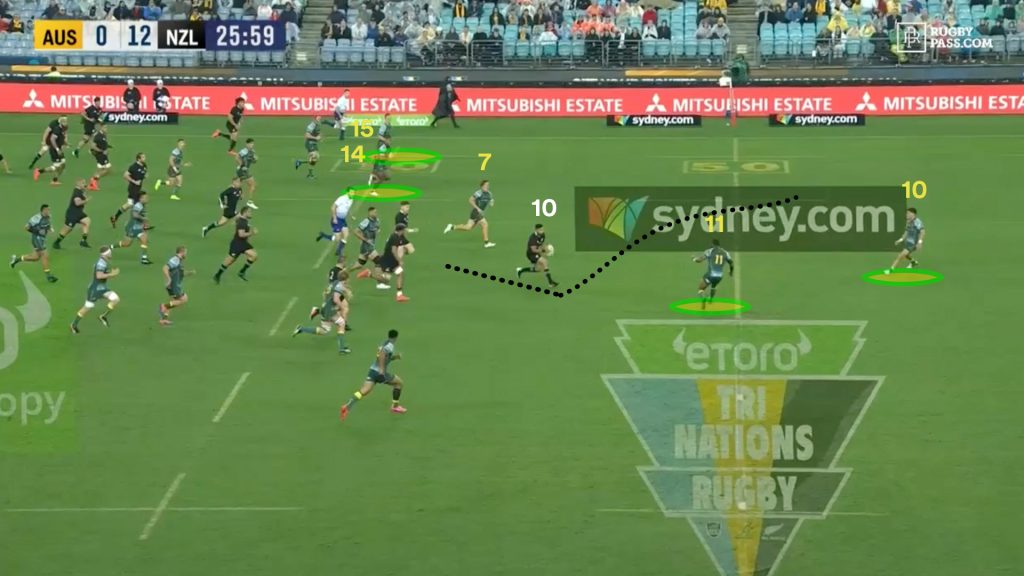
Both defenders took bad angles and Mo’unga left them grasping at air after he took the outside of Lolesio. There is no excuse for this miss, a one-on-two situation, it was overall poor defensive work from the setup of the backfield before the kick all the way to the non-execution of the closing tackle.
A similar situation occurred on Jordie Barrett’s try later in the second half, except on that occasion it was only one phase between turnover and try. Haylett-Petty decided to compete at the ruck instead of dropping back after the turnover and when Barrett sliced through the line, it was an open highway to the try line.
The overall performance of the Wallabies outside backs in the air, covering space, and on the edges was far from a desired standard.
Nic White’s spacial coverage in this first half was poor, as just when they needed him as a sweeper or an edge defender, he was doing the opposite, such as competing for the ball at the breakdown.
There isn’t a sole individual responsible for these errors, however, with scheme breakdowns combined with poor execution by multiple players each time leading to these easy scoring opportunities for the All Blacks.
The Wallabies did a much better job in defence from set-piece in the second half, making adjustments at half time to prevent a repeat some of what occurred in the first. They left one loose forward on the short side at all times and White made sure to stick to his role as the last man defender following a line out.
On the first All Blacks line out of the second half, Wilson (8) stayed out of the maul and stationed himself on the blind side with White until the All Blacks revealed their hand.

After the first phase crash run into the 10-channel, the Wallabies left blindside flanker Hanigan (6) as extra cover on the short side and White did his job sticking around as the edge defender. In the first half, they had sent the entire loose forward contingent to fold around the ruck.
Smith looked for the switch play momentarily but decided to go back to the open side after sensing White’s presence.


The Wallabies stuck to this plan in the second half and prevented any breaks coming off line out switch or blind side plays.
Number 8 Wilson stayed back next to White on the next lineout and put a well-timed shot on Anton Lienert-Brown when the All Blacks tried to run a switch after two phases. His rush defence in unison with White forced a gain line loss, much like how Samu and White had combined in Wellington to shut down the play.
However, despite this positive sign of improvement in the second half, the match was already lost after conceding 26 unanswered points before the halftime break. The expensive lesson is you have to get these things right the first time at test level.
Dane Haylett-Petty’s performance in this test was not a great endorsement of his selection over Tom Banks, who performed better in the air in New Zealand and offered a stable backfield with James O’Connor in the first two tests. Haylett-Petty went one from three in contestable aerial challenges in Sydney, contributing to a poor return of one from seven by the Wallabies team.
The Rebels fullback’s failure to react quickly to reinforce the backfield on two turnovers aided the All Blacks on two tries. As an experienced fullback, you would expect better leadership from Haylett-Petty in coordinating the backfield in the period of transition.
Marika Koroibete’s positioning in the backfield also left a lot to be desired but the real bottom line for the left wing is his handling has been atrocious to the point where his position his untenable, despite doing some good things in contact. This could see Brumbies wing Tom Wright enter the fray for a debut in Brisbane.
The issues with the communication among the Wallabies backrow need to be sorted to avoid a repeat of the calamitous showing in the first half in Sydney. This could see Pete Samu come back into the starting side, as these issues weren’t prevalent in the first test with him starting.
Some of the changes to Wallabies were forced through injury, but more were made by Rennie which has not helped build cohesion. Taniela Tupou and Hunter Paisami moved to the bench, despite starting in the 16-all draw.
The move to bolster the lineout with the inclusion of Ned Hanigan and promote a new thrower Brandon Paenga-Amosa over Folau Fainga’a has also cost the side in defence clearly.
It is a matter of ‘pick your poison’ for Rennie at this stage, but you would think a non-negotiable has to be defensive performance and that puts a few of these call-ups back in the firing line.



Comments
Join free and tell us what you really think!
Sign up for free